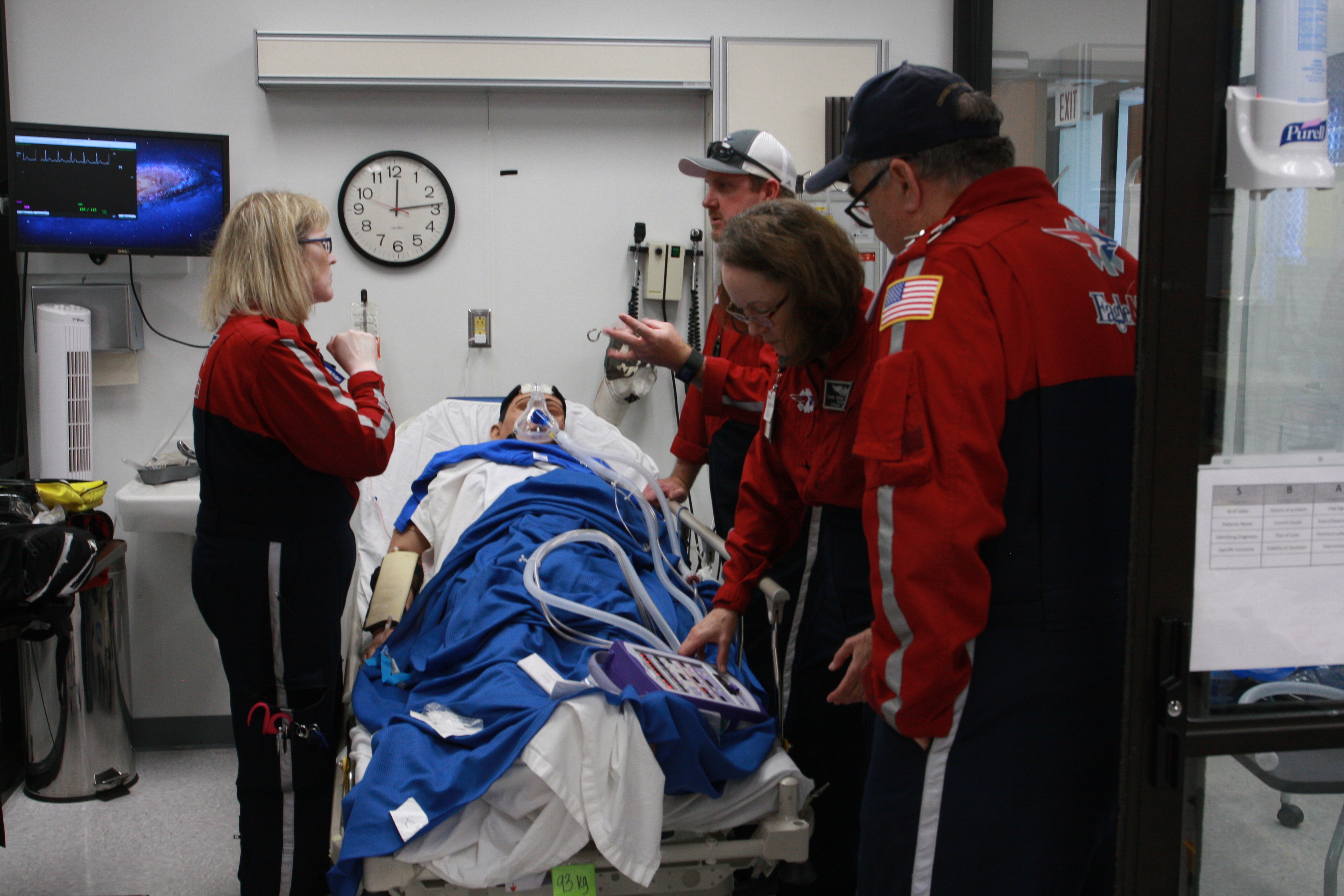Medical Flight Crews Train at DC3
Published May 22, 2018
by Scott Edger
On Tuesday, the Nursing and Allied Health Department at Dodge City Community College hosted a training simulation lab for more than two dozen regional emergency medical flight crew.
Advanced medical personnel from EagleMed, the medical air service serving Dodge City and the western Kansas region, convened both inside and outside the Allied Health building Wednesday morning as part of training the company conducts quarterly on campus.
Med-Trans Air Medical Transport operates EagleMed, and conducts its quarterly training for medical flight crews at DC3 in part due to the investment the college has made in advanced medical simulation mannequins and training equipment. The mannequins are capable of simulating a multitude of physical responses and creating any number of emergency conditions. Simulation mannequins used at the DC3 nursing program are even capable of generating audible responses to cues from student actions.
Access to the advanced facilities and training equipment at Dodge City Community College is invaluable for its more rural-based flight crews to maintain and update their skill sets and certifications, according to Mark Holcomb, program director for Med-Trans in western Kansas.
“It’s hard to find access to clinical training sites,” Holcomb said. “We’re trying to get more involved in simulation practice and training, but it’s fairly new in healthcare. So this community college is pretty progressive. They already have a fairly nice facility with the high-resolution mannequins. It’s been very helpful to us.”
The partnership between Med-Trans and Dodge City Community College began last fall, and provides benefits for not only the company and DC3 students, but also ensures high-quality emergency medical personnel for the community – filling a critical need in this far-flung, rural region.
DC3 nursing students benefit from the industry partnership by the exposure to advanced emergency practices and observation at Med-Trans bases at medical facilities. The partnership provides training equipment and facilities to flight nurses and paramedics from across the state.
Tuesday’s training scenarios depicted comprehensive, real-world incidents that are typical of potential accidents in our rural southwestern Kansas environment. The field scenario portrayed a teenager working on his family farm when his tractor rolled and pinned him beneath the tire.

Crews were tasked with stabilizing a patient with multiple internal injuries and compound fractures while being forced to wait for other emergency personnel with appropriate equipment to extricate the patient from beneath the tractor.
The “farm accident” was set up in a shallow culvert with a portable generator chugging nearby, simulating the potential noise from the helicopter or machinery. Crews were expected to communicate with one another, administer appropriate treatment, and respond to auditory cues from a patient in distress.
The flight crews also used the DC3 simulation lab to practice treating patients with acute respiratory failure. Advanced software operated from a laptop simulates critical vital signs and symptoms in the medical dummies, allowing instructors and examiners to create unexpected conditions that are often not replicable in an actual clinical setting.

Andrew Campfield, associate professor of nursing at Dodge City Community College, said EagleMed also brings flight crews to participate with nursing students’ simulations throughout the year to practice preparing patients for exchange and transport.
“We get to do a lot of interactive training between both sides,” Campfield said. “We try to show the students some of what’s out there, what they may be seeing when they go to work as a nurse.”
The dummies provide realistic clinical conditions that would not be otherwise possible with actual humans. Holcomb uses the analogy of a pilot being able to crash a plane in the simulator a hundred times in order to hone his skills. A tremendous amount of data is collected by the software and video recording of extreme situations, leading to more mastery of unforeseen medical emergencies.
“We have that advantage to be able to get in a lot of practice and repeat things over and over again,” Holcomb said. “If there are any problems they can repeat it, whereas in an actual clinical situation you wouldn’t be able to do that.”
EagleMed requires three to five years of critical care experience for employment consideration as a flight paramedic so current DC3 nursing students will need to progress in their careers, but Holcomb sees Dodge City Community College nursing program graduates as a source of quality healthcare professionals.
“Hopefully a lot of these students down the road will be folks we’re working with in the hospitals as a team partner or even as staff for us,” Holcomb said.
The agreement is a win-win for the school and the company, according to Campfield. He said he sees a great deal of potential for similar partnerships with area hospitals and medical facilities.
“EagleMed helps to provide training to the nursing students to prepare them for the professional world, and the school helps provide the EagleMed crews with training to keep them prepared,” he said. “It goes both ways so it’s a great partnership.”
EagleMed has a footprint of nine air-based and two ground-based operations in Kansas. Each base employs eight medical crew and four pilots.